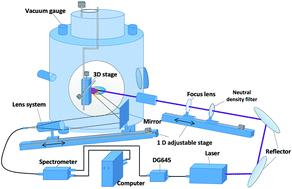当前位置:
X-MOL 学术
›
J. Anal. At. Spectrom.
›
论文详情
Our official English website, www.x-mol.net, welcomes your
feedback! (Note: you will need to create a separate account there.)
Highly depth-resolved characterization of fusion-related tungsten material based on picosecond laser-induced breakdown spectroscopy
Journal of Analytical Atomic Spectrometry ( IF 3.1 ) Pub Date : 2020-10-12 , DOI: 10.1039/d0ja00340a Dongye Zhao 1, 2, 3, 4, 5 , Ding Wu 3, 6, 7, 8, 9 , Jannis Oelmann 4, 5, 10, 11, 12 , Sebastijan Brezinsek 4, 5, 10, 11, 12 , Qingmei Xiao 3, 13, 14, 15 , Rongxing Yi 4, 5, 10, 11, 12 , Laizhong Cai 1, 2, 3 , Hongbin Ding 3, 6, 7, 8, 9
Journal of Analytical Atomic Spectrometry ( IF 3.1 ) Pub Date : 2020-10-12 , DOI: 10.1039/d0ja00340a Dongye Zhao 1, 2, 3, 4, 5 , Ding Wu 3, 6, 7, 8, 9 , Jannis Oelmann 4, 5, 10, 11, 12 , Sebastijan Brezinsek 4, 5, 10, 11, 12 , Qingmei Xiao 3, 13, 14, 15 , Rongxing Yi 4, 5, 10, 11, 12 , Laizhong Cai 1, 2, 3 , Hongbin Ding 3, 6, 7, 8, 9
Affiliation

|
The objective of the present study has been to evaluate the potential applications of picosecond laser-induced breakdown spectroscopy (ps-LIBS) in nuclear fusion devices. The laser-ablation behaviors and the spectral emission features of ps-LIBS at broad laser fluences have been investigated under a high vacuum using a 35 ps laser with λ = 355 nm in order to achieve high depth-resolution diagnosis of the key fusion-related material, tungsten (W). For the ablation behaviors, three ablation regimes in laser fluences have been clearly identified, both in terms of average ablation rate (AAR) changes and surface morphology variations. For the spectral emission features of ps-LIBS investigated utilizing CCD and ICCD spectrometers, the intensities of the continuum background and atomic lines emission showed the different rising tendencies with the laser fluence in these three ablation regimes. Three representative craters in the three ablation regimes were characterized by scanning electron microscopy (SEM) to investigate the crater morphologies and microstructures. The results for the ablation rates and spectral emission features as well as the crater morphologies suggest that the first ablation regime was a superior choice for the diagnosis of the W wall by ps-LIBS due to the limited AAR (<40 nm per pulse), the small thermal effect, and thus the potentially high depth-resolution capacity. Further, the AARs and spectral emission features of ps-LIBS as a function of the ablation crater diameter in the first ablation regime were systematically studied. The results demonstrate that the AAR was weakly dependent on the crater diameter when keeping the same laser fluence, while the spectral intensities of the ps-LIBS increased significantly with the crater diameter increasing. Moreover, a rectangle-like cross-section of the crater could be achieved in the first ablation regime. This has a unique benefit for depth analysis of the deposited layer on the first wall of nuclear fusion devices by ps-LIBS.
中文翻译:

基于皮秒激光诱导击穿光谱的熔融相关钨材料的高度深度分辨表征
本研究的目的是评估皮秒激光诱导击穿光谱(ps-LIBS)在核聚变设备中的潜在应用。在高真空下使用λ为35 ps的激光器研究了ps-LIBS在宽激光注量下的激光烧蚀行为和光谱发射特性= 355 nm,以便对关键的融合相关材料钨(W)进行高深度分辨率诊断。对于烧蚀行为,已经明确地确定了激光注量中的三种烧蚀方案,包括平均烧蚀率(AAR)变化和表面形态变化。对于使用CCD和ICCD光谱仪研究的ps-LIBS的光谱发射特征,在这三种烧蚀方式下,连续背景强度和原子线发射强度显示出随着激光能量密度的不同上升趋势。通过扫描电子显微镜(SEM)表征了三种烧蚀方式中的三个代表性陨石坑,研究了陨石坑的形态和微观结构。烧蚀率和光谱发射特征以及陨石坑形态的结果表明,由于有限的AAR(每个脉冲<40 nm),第一种烧蚀方案是ps-LIBS诊断W壁的最佳选择,较小的热效应,因此可能具有较高的深度分辨率。此外,系统地研究了第一消融方案中ps-LIBS的AAR和谱发射特征随消融坑口直径的变化。结果表明,当保持相同的激光通量时,AAR几乎不依赖于弹坑直径,而ps-LIBS的光谱强度随着弹坑直径的增加而显着增加。此外,在第一烧蚀方案中可以实现环形凹坑的矩形横截面。
更新日期:2020-11-03
中文翻译:

基于皮秒激光诱导击穿光谱的熔融相关钨材料的高度深度分辨表征
本研究的目的是评估皮秒激光诱导击穿光谱(ps-LIBS)在核聚变设备中的潜在应用。在高真空下使用λ为35 ps的激光器研究了ps-LIBS在宽激光注量下的激光烧蚀行为和光谱发射特性= 355 nm,以便对关键的融合相关材料钨(W)进行高深度分辨率诊断。对于烧蚀行为,已经明确地确定了激光注量中的三种烧蚀方案,包括平均烧蚀率(AAR)变化和表面形态变化。对于使用CCD和ICCD光谱仪研究的ps-LIBS的光谱发射特征,在这三种烧蚀方式下,连续背景强度和原子线发射强度显示出随着激光能量密度的不同上升趋势。通过扫描电子显微镜(SEM)表征了三种烧蚀方式中的三个代表性陨石坑,研究了陨石坑的形态和微观结构。烧蚀率和光谱发射特征以及陨石坑形态的结果表明,由于有限的AAR(每个脉冲<40 nm),第一种烧蚀方案是ps-LIBS诊断W壁的最佳选择,较小的热效应,因此可能具有较高的深度分辨率。此外,系统地研究了第一消融方案中ps-LIBS的AAR和谱发射特征随消融坑口直径的变化。结果表明,当保持相同的激光通量时,AAR几乎不依赖于弹坑直径,而ps-LIBS的光谱强度随着弹坑直径的增加而显着增加。此外,在第一烧蚀方案中可以实现环形凹坑的矩形横截面。











































 京公网安备 11010802027423号
京公网安备 11010802027423号